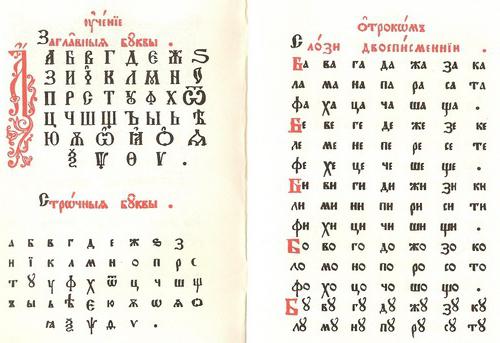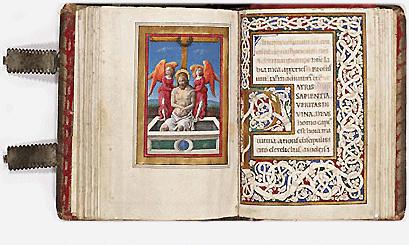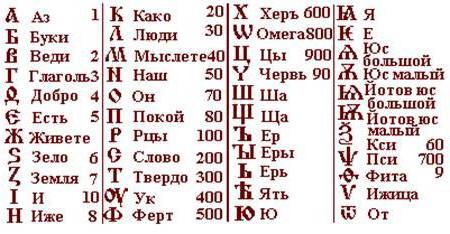The alphabet of the Old Slavonic language is a collection of written characters in a certain order expressing specific sounds. This system developed independently enough on the territory of the ancient Russian peoples.
Brief historical background
At the end of 862, Prince Rostislav turned to Michael (the Byzantine emperor) with a request to send preachers to his principality (Great Moravia) in order to spread Christianity in the Slavic language. The fact is that it was read at that time in Latin, which was unfamiliar and incomprehensible to the people. Michael sent two Greeks - Constantine (he will receive the name Cyril later in 869 when he became a monk) and Methodius (his elder brother). This choice was not accidental. The brothers were from Soluni (Thessaloniki in Greek), from the family of a military leader. Both received a good education. Konstantin was trained at the court of Emperor Michael the Third, had a good command of different languages, including Arabic, Jewish, Greek, Slavic. In addition, he taught philosophy, for which he was called - Konstantin Philosopher. Methodius was first in military service, and then ruled for several years in one of the areas in which the Slavs lived. Subsequently, the elder brother went to the monastery. This was not their first trip - in the year 860, the brothers made a trip to the Khazars with a diplomatic and missionary goal.

How was the written sign system created?
In order to preach in the Slavic language, it was necessary to translate the Holy Scripture. But a written sign system did not exist at that time. Konstantin set about creating the alphabet. Methodius actively helped him. As a result, in 863, the Old Slavonic alphabet (the meaning of the letters from it will be given below) was created. The system of written signs existed in two forms: Glagolitic and Cyrillic. To this day, scientists disagree on which of these options was created by Cyril. With the participation of Methodius, some Greek liturgical books were translated. So the Slavs got the opportunity to write and read in their own language. In addition, the people received not only a system of written signs. The Old Slavonic alphabet became the basis for the literary vocabulary. Some words can still be found in Ukrainian, Russian, Bulgarian dialects.
First characters - first word
The first letters of the Old Slavonic alphabet - "az" and "beeches" - added up, in fact, the name. They corresponded to "A" and "B" and began a system of signs. What did the Old Slavonic alphabet look like? Graffiti pictures were first scratched right on the walls. The first signs appeared around the 9th century, on the walls in the churches of Pereslavl. And in the 11th century, the Old Slavonic alphabet, the translation of some signs and their interpretation appeared in Kiev, in St. Sophia Cathedral. A new round in the development of writing contributed to the event that occurred in 1574. Then the first printed "Old Slavonic alphabet" appeared. Its creator was Ivan Fedorov.
Relationship of Times and Events
If you look back, you can note with some interest that the Old Slavonic alphabet was not just an ordered set of written symbols. This system of signs opened to the people a new path leading to perfection of man on earth and to a new faith. Researchers, looking at the chronology of events, the difference between which is only 125 years old, suggest a direct connection between the statement of Christianity and the creation of written symbols. In one century, practically people were able to eradicate the old archaic culture and adopt a new faith. Most historians have no doubt that the emergence of a new written system is directly related to the subsequent adoption and spread of Christianity. The Old Slavonic alphabet, as already mentioned above, was created in 863, and in 988 Vladimir officially announced the introduction of a new faith and the destruction of the primitive cult.
The mystery of the sign system
Many scholars, studying the history of the creation of writing, come to the conclusion that the letters of the Old Slavonic alphabet were a kind of cryptography. It had not only a deep religious, but also philosophical meaning. Along with this, Old Slavonic letters make up a complex logical-mathematical system. Comparing the findings, the researchers conclude that the first collection of written symbols was created as a kind of holistic invention, and not as a structure that was formed in parts by adding new forms. The signs of which the Old Slavonic alphabet consisted are interesting. Most of them are number characters. The Cyrillic alphabet is based on the Greek uncial writing system. There were 43 letters in the Old Slavonic alphabet. 24 characters were borrowed from the Greek uncial, 19 were new. The fact is that in the Greek language there were not some sounds that the Slavs had at that time. Accordingly, their lettering was not there either. Therefore, part of the characters from the new, 19, was borrowed from other written systems, and part was created specially by Konstantin.

"Higher" and "lower" part
If you look at this entire written system, you can clearly enough distinguish two parts of it that are fundamentally different from each other. Conventionally, the first part is called "higher", and the second, respectively, "lower". The 1st group includes the letters AF ("az" - "Firth"). They are a list of word characters. Their meaning was clear to any Slav. The "lower" part began with "sha" and ended with "izhitsa". These characters had no numerical value and carried a negative connotation in themselves. To understand the cryptography is not enough just to look at it fluently. You should read the symbols - after all, in each of them Konstantin put the semantic core. What did the symbols that made up the Old Slavonic alphabet symbolize?
The meaning of the letters
"Az", "beeches", "lead" - these three characters stood at the very beginning of the system of written signs. The first letter was az. It was used in the form of the pronoun "I". But the basic meaning of this symbol is such words as "beginning", "begin", "initially". In some letters you can find "az", denoting the number "one": "I will go az to Vladimir." Or this symbol was interpreted as "start with the basics" (first). By this letter, therefore, the Slavs designated the philosophical meaning of their being, indicating that there is no end without a beginning, no light without darkness, no evil without good. In this case, the main emphasis was placed on the duality of the structure of the world. But the Old Slavonic alphabet itself, in fact, is composed according to the same principle and is divided into 2 parts, as already mentioned above, “higher” (positive) and “lower” (negative). "Az" corresponded to the number "1", which, in turn, symbolized the beginning of all that is beautiful. Studying the numerology of the people, researchers say that all the numbers were then divided by people into even and odd ones. Moreover, the former were associated with something negative, and the latter symbolized something good, bright, positive.

Beeches
This letter followed the az. "Buki" did not have a digital meaning. However, the philosophical meaning of this symbol was no less deep. “Beeches” is “to be,” “will be.” As a rule, it was used in revolutions in the future tense. So, for example, “Boudy” means “let it be”, “future” - “upcoming”, “future”. With this word, the ancient Slavs expressed the inevitability of upcoming events. At the same time, they could be both terrible and gloomy, and rainbow and good. It is not known exactly why Konstantin did not give the second letter a numerical value. Many researchers believe that this may be due to the duality of the meaning of the letter itself.
"Lead"
This symbol is of particular interest. "Vedi" corresponds to the number 2. The symbol is translated as "own", "know", "know." Putting such a meaning in the "lead", Konstantin meant knowledge - as a divine supreme gift. And if you add the first three characters, the phrase "I will know." By this, Konstantin wanted to show that the person who opens the ABC will subsequently receive knowledge. It should be said about the semantic load of the "lead." The number "2" is a deuce, the couple took part in various magical rituals, and on the whole indicated the duality of everything earthly and heavenly. "Two" among the Slavs meant the union of earth and sky. In addition, this figure symbolized the duality of man himself - the presence of good and evil in him. In other words, “2” is a constant confrontation between the parties. It should also be noted that the "deuce" was considered the number of the devil - many negative properties were attributed to it. It was believed that it was she who discovered a number of negative numbers that bring death to man. In this regard, the birth of twins, for example, was considered a bad sign, bringing illness and misfortune to the whole family. It was considered a bad omen to rock the cradle together, wipe two people with one towel, and generally do something together. However, even with all the negative qualities of the deuce, people recognized its magical properties. And in many rituals, twins took part or the same objects were used to expel evil spirits.

Symbols as a secret message to posterity
All Old Slavonic letters are uppercase. For the first time, two varieties of written symbols - lowercase and uppercase - were introduced by Peter the Great in 1710. If you look at the Old Slavonic alphabet - the meaning of letters and words, in particular - you can understand that Konstantin did not just compose a written system, but tried to convey a special meaning to posterity. So, for example, if you add these or those characters, you can get phrases of an edifying character:
“Lead the Verb” - lead the doctrine;
“Firmly Ouk” - strengthen the law;
"Rtsy Word Firmly" - speak true words, etc.
Drawing order and style
Researchers studying the alphabet, consider the order of the first, "higher" part from two positions. First of all, each character is added, followed by a meaningful phrase. This can be considered a nonrandom regularity, which was probably invented for easier and faster memorization of the alphabet. In addition, the system of written signs can be considered from the point of view of numerology. After all, the letters corresponded to the numbers, which were arranged in ascending order. So, "az" - A - 1, B - 2, then G - 3, then D - 4 and then to ten. Dozens started from "K". They were listed in the same order of units: 10, 20, then 30, etc. to 100. Despite the fact that Old Slavonic letters were written with patterns, they were convenient and simple. All characters were perfect for cursive writing. As a rule, people did not have difficulty in depicting letters.
Written Sign System Development
If we compare the Old Slavonic and the modern alphabet, we can see that 16 letters are lost. Cyrillic today corresponds to the sound composition of Russian vocabulary. This is primarily due to the not so sharp divergence of the very structure of the Slavic and Russian languages. It is also important that when compiling the Cyrillic alphabet, Konstantin carefully took into account the phonemic (sound) composition of speech. In the Old Slavic alphabet, there were seven Greek written characters, initially unnecessary to convey the sounds of the Old Slavonic language: omega, xi, psi, fita, izhitsa. In addition, two signs were present in the system, to indicate the sound “and” and “z”: for the second - “green” and “earth”, for the first - “and” and “like”. This designation was somewhat redundant. The inclusion of these letters in the alphabet was supposed to ensure the correct pronunciation of the sounds of Greek speech in the words borrowed from it. But the sounds were pronounced in the old Russian way. Therefore, the need to use these written characters over time has disappeared. It was also important to change the application and meaning of the letters "er" ("b") and "er" (b). Initially, they were used to denote a weakened (reduced) deaf vowel: "b" - close to "o", "b" - close to "e". Over time, weak, dull vowels began to disappear (this process was called the “fall of the deaf”), and these symbols received other tasks.
Conclusion
Many thinkers saw in the digital correspondence of written symbols the principle of the triad, spiritual balance, which a person achieves in his pursuit of truth, light, and good. Studying the alphabet from its very beginnings, many researchers conclude that Konstantin left his descendants a priceless creation, calling for self-improvement, wisdom and love, learning, bypassing the dark paths of enmity, envy, anger, evil.